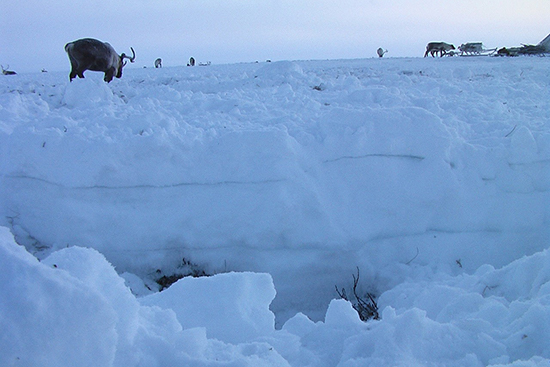Increasing rainfall in the Arctic causes many kind of problems. Photo: Lauren Candlish.
More rain than snow will fall in the Arctic – and this transition will occur decades earlier than previously predicted, a new study reports.
Projections from the newest climate models, published by an international team led by the University of Manitoba in the journal Nature Communications, show a steep increase in precipitation expected to fall in the Arctic, and that most of it will be rain.
This shift is occurring due to rapid warming and sea-ice loss in the Arctic.
– There are huge ramifications of these changes, such as a reduction of snow cover, increased permafrost melt, more rain-on-snow events, and greater flooding events from increased river discharge, all of which have implications on wildlife populations and human livelihoods, said lead researcher Michelle McCrystall, a postdoctoral fellow in Centre for Earth Observation Science in the Clayton H. Riddell Faculty of Environment, Earth, and Resources.
– The new models couldn’t be clearer that unless global warming is stopped, the future Arctic will be wetter; once-frozen seas will be open water, rain will replace snow, say Professor James Screen, of the Department of Mathematics and Global Systems Institute at the University of Exeter.
This transition to a rain-dominated era in the Arctic is forecasted to commence at different times depending on the season and region. In autumn, for instance, these new models predict the shift to occur between 2050–2080, whereas the old models predicted this to occur decades later.
The paper warns that reduced snow cover will further exacerbate Arctic and global warming through albedo feedbacks, increased winter CO2 fluxes, methane releases from soil, and thawing permafrost.
The precipitation change will also affect soil moisture and groundwater, and the underground fungal networks that support all above-ground flora.
More rain-on-snow events can be devastating to wild caribou, semi-domesticated reindeer and muskoxen populations.
Research professor Bruce Forbes, at the Arctic Centre, University of Lapland leads a large EU-funded consortium project, CHARTER, which also studies the drivers and feedbacks of rain-on-snow events across northern Eurasia.
– Since 2006 a group of us within the CHARTER team have been ‘fingerprinting’ massive rain-on-snow events over the Russian Arctic mainland. Light and infrequent rains during autumn and spring have been replaced by more frequent and intensive rainstorms. The thick ice crusts which form when the air cools can be impenetrable, leading to catastrophic starvation of tens of thousands of private and collectively owned reindeer, Forbes tells.
At herders’ request researchers have studied the processes leading to rain on snow, so that they can improve predictions of where and when they may occur.
– Supplemental feeding, which has occurred within Finland for decades to buffer against heavy mortality is expensive, affects animal behaviour and taste, and is not a long-term solution. In Arctic Russia, tundra Nenets herders would prefer to continue without supplemental feeding. Hard decisions lay head by herders and administrators as science sounds the alarm in term of what the weather and climate portend in future decades, Forbes continues.
The authors of the paper note that if we can remain under 1.5 °C of global warming, then the transition to a rainfall dominated precipitation may not occur in some regions of the Arctic. But if we continue on the current trajectory, which given current global policies means that we could reach 3 °C global warming by the end of the century, this transition will likely occur.

Two layers of ice in deep snow following the rain-on-snow event. Photo: Florian Stammler.
This research was undertaken, in part, thanks to funding from the Canada Research Chairs Program, the European Commission Research and Innovation (CHARTER) and the Natural Environment Research Council.
More information:
Bruce Forbes
Research professor
Arctic Centre, University of Lapland
bruce.forbes(at)ulapland.fi
040 847 9202